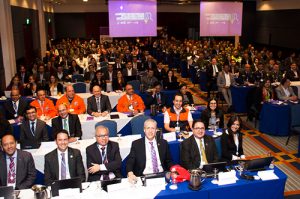New technologies for risk reduction, early warning and multi-hazard monitoring systems, plus the role of the private sector in crisis management, were the key discussion topics at the “Second Multi-Stakeholder Forum on the Role of Telecommunications/ICT in Disaster Management”, held in Bogotá from 29 to 31 August 2017.
 The Forum was jointly organised by Colombia’s Ministry of Information and Communications Technology (MinTIC) and International Telecommunication Union (ITU). Speaking at the opening, Juan Sebastián Rozo, Vice Minister of Connectivity and Digitisation of MinTIC, said “This Forum is an excellent opportunity to exchange the experiences and best practices of various countries in the use of modern technologies in disaster management, demonstrating how ICT can be used to save lives”. Vice Minister Rozo added that the forum was an important part of Colombian Government efforts to consolidate the National Emergency Telecommunications System.
The Forum was jointly organised by Colombia’s Ministry of Information and Communications Technology (MinTIC) and International Telecommunication Union (ITU). Speaking at the opening, Juan Sebastián Rozo, Vice Minister of Connectivity and Digitisation of MinTIC, said “This Forum is an excellent opportunity to exchange the experiences and best practices of various countries in the use of modern technologies in disaster management, demonstrating how ICT can be used to save lives”. Vice Minister Rozo added that the forum was an important part of Colombian Government efforts to consolidate the National Emergency Telecommunications System.
Participants in the Forum included global and Latin American experts from digital ecosystem companies, telecommunications ministries and regulators, national risk management bodies and humanitarian organisations. Randall Trevino, Deputy Director, ITU Regional Office for the Americas, said that telecommunications contribute to emergency and disaster response by helping to coordinate local populations, emergency relief groups, authorities and private entities.
Mobile ecosystem commits to disaster response
“In most cases, lives are saved in a disaster because of the efforts of local people. That makes the scale and reach of mobile connectivity essential in connecting people and providing access to key information to support immediate response,” said Mauro Accurso, Communications and Sustainability Manager, GSMA Latin America, during his presentation at the Forum.
 Colombia’s mobile industry pledged to work together on disaster preparedness and response by signing the Humanitarian Connectivity Charter as part of the We Care campaign in September 2016. Operators deployed their resources to help publicise the National Evacuation Drill and the Search and Rescue Drill organised by Colombia’s National Unit for Risk and Disaster Management (UNGRD), reaching out to 1.9 million people.
Colombia’s mobile industry pledged to work together on disaster preparedness and response by signing the Humanitarian Connectivity Charter as part of the We Care campaign in September 2016. Operators deployed their resources to help publicise the National Evacuation Drill and the Search and Rescue Drill organised by Colombia’s National Unit for Risk and Disaster Management (UNGRD), reaching out to 1.9 million people.
The role of Claro, Telefónica Movistar and TigoUne was also very important during the tragedy in the Colombian municipality of Mocoa caused by heavy rain, overflowing rivers and landslides during the night of 31 March and the early hours of 1 April 2017. Mobile operators headed a strong fundraising campaign through SMS and mobile and land lines, raising millions of pesos for victims. They also gave free credit vouchers to the affected population and provided significant support in response logistics and rebuilding.
Big data for disaster management
The humanitarian sector has experienced more disruption due to technology in the past decade than in the past 50 years, empowering response teams and local people with connectivity and improving logistics systems, risk analysis, preparedness, early warning and rebuilding. Future innovation will lie in Big Data for disaster management. Through analysis of large datasets, human behaviour can be measured on a large scale to provide key inputs into decision making.
Aiming to promote innovative solutions to improve communication during crises and emergencies, the GSMA has launched the Disaster Response Innovation Fund. This initiative will fund the testing or scaling of ideas and projects that include at least two stakeholders: mobile network operators, companies, NGOs, national emergency/environmental bodies and/or humanitarian agencies. Applications are open until 13 October.